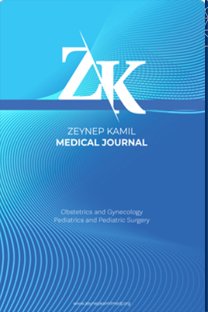Fetal megacystis at 11–14 weeks of gestation: 3-year experience of a tertiary center
Fetal megacystis at 11–14 weeks of gestation: 3-year experience of a tertiary center
___
- 1. McHugo J, Whittle M. Enlarged fetal bladders: Aetiology, management and outcome. Prenat Diagn 2001;21:958–63.
- 2. Sebire NJ, Von Kaisenberg C, Rubio C, Snijders RJ, Nicolaides KH. Fe- tal megacystis at 10-14 weeks of gestation. Ultrasound Obstet Gynecol 1996;8:387–90.
- 3. Taghavi K, Sharpe C, Stringer MD. Fetal megacystis: A systematic re- view. J Pediatr Urol 2017;13:7–15.
- 4. Fontanella F, Duin L, Adama van Scheltema PN, Cohen-Overbeek TE, Pajkrt E, Bekker M, et al. Antenatal workup of early megacystis and se- lection of candidates for fetal therapy. Fetal Diagn Ther 2019;45:155–61.
- 5. Fontanella F, Duin L, Adama van Scheltema PN, Cohen-Overbeek TE, Pajkrt E, Bekker M, et al. Fetal megacystis: Prediction of spontaneous resolution and outcome. Ultrasound Obstet Gynecol 2017;50:458–63.
- 6. Montemarano H, Bulas DI, Rushton HG, Selby D. Bladder distention and pyelectasis in the male fetus: Causes, comparisons, and contrasts. J Ultrasound Med 1998;17:743–9.
- 7. Kim SK, Won HS, Shim JY, Kim KS, Lee PR, Kim A. Successful vesi- coamniotic shunting of posterior urethral valves in the first trimester of pregnancy. Ultrasound Obstet Gynecol 2005;26:666–8.
- 8. Müller Brochut AC, Thomann D, Kluwe W, Di Naro E, Kuhn A, Raio L. Fetal megacystis: Experience of a single tertiary center in Switzerland over 20 years. Fetal Diagn Ther 2014;36:215–22.
- 9. Robyr R, Benachi A, Daikha-Dahmane F, Martinovich J, Dumez Y, Ville Y. Correlation between ultrasound and anatomical findings in fetuses with lower urinary tract obstruction in the first half of pregnancy. Ultra- sound Obstet Gynecol 2005;25:478–82.
- 10. Favre R, Kohler M, Gasser B, Muller F, Nisand I. Early fetal megacys- tis between 11 and 15 weeks of gestation. Ultrasound Obstet Gynecol 1999;14:402–6.
- 11. Liao AW, Sebire NJ, Geerts L, Cicero S, Nicolaides KH. Megacystis at 10-14 weeks of gestation: Chromosomal defects and outcome accord- ing to bladder length. Ultrasound Obstet Gynecol 2003;21:338–41.
- 12. Syngelaki A, Guerra L, Ceccacci I, Efeturk T, Nicolaides KH. Impact of holoprosencephaly, exomphalos, megacystis and increased nuchal translucency on first-trimester screening for chromosomal abnormali- ties. Ultrasound Obstet Gynecol 2017;50:45–8.
- 13. Fontanella F, Maggio L, Verheij JBGM, Duin LK, Adama Van Scheltema PN, Cohen-Overbeek TE, et al. Fetal megacystis: A lot more than LUTO. Ultrasound Obstet Gynecol 2019;53:779–87.
- 14. Malin G, Tonks AM, Morris RK, Gardosi J, Kilby MD. Congenital low- er urinary tract obstruction: A population-based epidemiological study. BJOG 2012;119:1455–64.
- 15. Al-Hazmi H, Dreux S, Delezoide AL, Dommergues M, Lortat-Jacob S, Oury JF, et al. Outcome of prenatally detected bilateral higher urinary tract obstruction or megacystis: Sex-related study on a series of 709 cases. Prenat Diagn 2012;32:649–54.
- 16. Nassr AA, Shazly SAM, Abdelmagied AM, Araujo Júnior E, Tonni G, Kilby MD, et al. Effectiveness of vesicoamniotic shunt in fetuses with congenital lower urinary tract obstruction: An updated systematic review and meta-analysis. Ultrasound Obstet Gynecol 2017;49:696–703.
- 17. Ruano R, Yoshisaki CT, Salustiano EM, Giron AM, Srougi M, Zugaib M. Early fetal cystoscopy for first-trimester severe megacystis. Ultrasound Obstet Gynecol 2011;37:696–701.
- 18. Ruano R, Sananes N, Sangi-Haghpeykar H, Hernandez-Ruano S, Moog R, Becmeur F, et al. Fetal intervention for severe lower urinary tract ob- struction: A multicenter case-control study comparing fetal cystoscopy with vesicoamniotic shunting. Ultrasound Obstet Gynecol 2015;45:452–8.
- 19. Strizek B, Gottschalk I, Recker F, Weber E, Flöck A, Gembruch U, et al. Vesicoamniotic shunting for fetal megacystis in the first trimester with a Somatex® intrauterine shunt. Arch Gynecol Obstet 2020;302:133–
- ISSN: 1300-7971
- Yayın Aralığı: Yılda 4 Sayı
- Yayıncı: Ali Cangül
Evaluation of the relationship between dental caries and urinary tract infections
Fedli Emre KILIÇ, Habip ALMİŞ, İbrahim Hakan BUCAK, Mehmet TURGUT
Kutlay GÜR, Nihan UYGUR KÜLCÜ, Özlem ERDEDE, Erdal SARI, Rabia Gönül SEZER YAMANEL, Abdulkadir BOZAYKUT
Halenur BOZDAĞ, Belgin DEVRANOĞLU, Esra AKDENİZ, Nazan YURTÇU, Nurullah PEKER
Nihan UYGUR KÜLCÜ, Züleyha Aysu SAY, Habibe AYVACI TAŞAN, Handan ÇETİNER, Zeynep Gamze KILIÇOĞLU
Surgical treatment of the rectal prolapse in children: A review
Cengiz GÜL, Sabri CANSARAN, Ayşenur CELAYİR
Effect of COVID-19 on anesthesia preferences in cesarean section: An observational study
Meryem ONAY, Sema ŞANAL BAŞ, Ümit AKKEMİK, Ayten BİLİR
Evaluation of voiding functions with the micturition video: The preliminary results
Tuğçe Merve ORBAY, Ayşenur CELAYİR, Cengiz GÜL, Bekir ERDEVE
Serkan ORAL, Alper ŞİŞMANOĞLU, Yaşam Kemal AKPAK, Sebahattin ÇELİK, Nazan YURTÇU
Serum follistatin-like-3 levels in the diagnosis of tubal ectopic pregnancy
Işıl AYHAN, Ahter Tanay TAYYAR, İsmail DAĞ, Melike ALTINTAŞ, Hakan BİLGESOY, Betül YILMAZER
